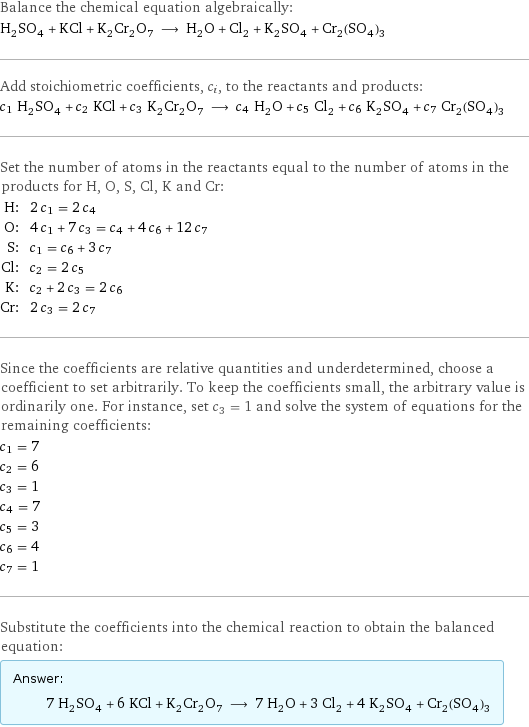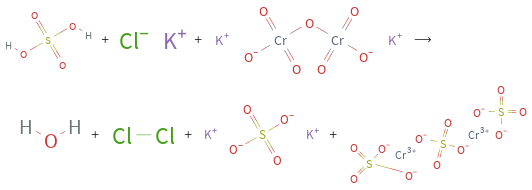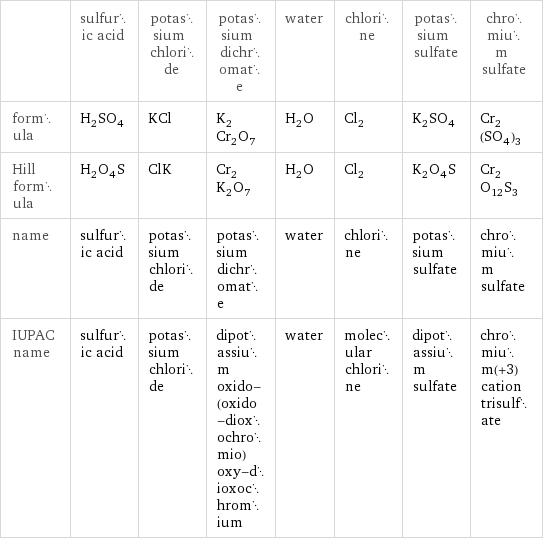Input interpretation

H_2SO_4 sulfuric acid + KCl potassium chloride + K_2Cr_2O_7 potassium dichromate ⟶ H_2O water + Cl_2 chlorine + K_2SO_4 potassium sulfate + Cr_2(SO_4)_3 chromium sulfate
Balanced equation

Balance the chemical equation algebraically: H_2SO_4 + KCl + K_2Cr_2O_7 ⟶ H_2O + Cl_2 + K_2SO_4 + Cr_2(SO_4)_3 Add stoichiometric coefficients, c_i, to the reactants and products: c_1 H_2SO_4 + c_2 KCl + c_3 K_2Cr_2O_7 ⟶ c_4 H_2O + c_5 Cl_2 + c_6 K_2SO_4 + c_7 Cr_2(SO_4)_3 Set the number of atoms in the reactants equal to the number of atoms in the products for H, O, S, Cl, K and Cr: H: | 2 c_1 = 2 c_4 O: | 4 c_1 + 7 c_3 = c_4 + 4 c_6 + 12 c_7 S: | c_1 = c_6 + 3 c_7 Cl: | c_2 = 2 c_5 K: | c_2 + 2 c_3 = 2 c_6 Cr: | 2 c_3 = 2 c_7 Since the coefficients are relative quantities and underdetermined, choose a coefficient to set arbitrarily. To keep the coefficients small, the arbitrary value is ordinarily one. For instance, set c_3 = 1 and solve the system of equations for the remaining coefficients: c_1 = 7 c_2 = 6 c_3 = 1 c_4 = 7 c_5 = 3 c_6 = 4 c_7 = 1 Substitute the coefficients into the chemical reaction to obtain the balanced equation: Answer: | | 7 H_2SO_4 + 6 KCl + K_2Cr_2O_7 ⟶ 7 H_2O + 3 Cl_2 + 4 K_2SO_4 + Cr_2(SO_4)_3
Structures

+ + ⟶ + + +
Names

sulfuric acid + potassium chloride + potassium dichromate ⟶ water + chlorine + potassium sulfate + chromium sulfate
Equilibrium constant
![Construct the equilibrium constant, K, expression for: H_2SO_4 + KCl + K_2Cr_2O_7 ⟶ H_2O + Cl_2 + K_2SO_4 + Cr_2(SO_4)_3 Plan: • Balance the chemical equation. • Determine the stoichiometric numbers. • Assemble the activity expression for each chemical species. • Use the activity expressions to build the equilibrium constant expression. Write the balanced chemical equation: 7 H_2SO_4 + 6 KCl + K_2Cr_2O_7 ⟶ 7 H_2O + 3 Cl_2 + 4 K_2SO_4 + Cr_2(SO_4)_3 Assign stoichiometric numbers, ν_i, using the stoichiometric coefficients, c_i, from the balanced chemical equation in the following manner: ν_i = -c_i for reactants and ν_i = c_i for products: chemical species | c_i | ν_i H_2SO_4 | 7 | -7 KCl | 6 | -6 K_2Cr_2O_7 | 1 | -1 H_2O | 7 | 7 Cl_2 | 3 | 3 K_2SO_4 | 4 | 4 Cr_2(SO_4)_3 | 1 | 1 Assemble the activity expressions accounting for the state of matter and ν_i: chemical species | c_i | ν_i | activity expression H_2SO_4 | 7 | -7 | ([H2SO4])^(-7) KCl | 6 | -6 | ([KCl])^(-6) K_2Cr_2O_7 | 1 | -1 | ([K2Cr2O7])^(-1) H_2O | 7 | 7 | ([H2O])^7 Cl_2 | 3 | 3 | ([Cl2])^3 K_2SO_4 | 4 | 4 | ([K2SO4])^4 Cr_2(SO_4)_3 | 1 | 1 | [Cr2(SO4)3] The equilibrium constant symbol in the concentration basis is: K_c Mulitply the activity expressions to arrive at the K_c expression: Answer: | | K_c = ([H2SO4])^(-7) ([KCl])^(-6) ([K2Cr2O7])^(-1) ([H2O])^7 ([Cl2])^3 ([K2SO4])^4 [Cr2(SO4)3] = (([H2O])^7 ([Cl2])^3 ([K2SO4])^4 [Cr2(SO4)3])/(([H2SO4])^7 ([KCl])^6 [K2Cr2O7])](../image_source/ffd3e7a8f2cf71417027ce5f4f9b6d94.png)
Construct the equilibrium constant, K, expression for: H_2SO_4 + KCl + K_2Cr_2O_7 ⟶ H_2O + Cl_2 + K_2SO_4 + Cr_2(SO_4)_3 Plan: • Balance the chemical equation. • Determine the stoichiometric numbers. • Assemble the activity expression for each chemical species. • Use the activity expressions to build the equilibrium constant expression. Write the balanced chemical equation: 7 H_2SO_4 + 6 KCl + K_2Cr_2O_7 ⟶ 7 H_2O + 3 Cl_2 + 4 K_2SO_4 + Cr_2(SO_4)_3 Assign stoichiometric numbers, ν_i, using the stoichiometric coefficients, c_i, from the balanced chemical equation in the following manner: ν_i = -c_i for reactants and ν_i = c_i for products: chemical species | c_i | ν_i H_2SO_4 | 7 | -7 KCl | 6 | -6 K_2Cr_2O_7 | 1 | -1 H_2O | 7 | 7 Cl_2 | 3 | 3 K_2SO_4 | 4 | 4 Cr_2(SO_4)_3 | 1 | 1 Assemble the activity expressions accounting for the state of matter and ν_i: chemical species | c_i | ν_i | activity expression H_2SO_4 | 7 | -7 | ([H2SO4])^(-7) KCl | 6 | -6 | ([KCl])^(-6) K_2Cr_2O_7 | 1 | -1 | ([K2Cr2O7])^(-1) H_2O | 7 | 7 | ([H2O])^7 Cl_2 | 3 | 3 | ([Cl2])^3 K_2SO_4 | 4 | 4 | ([K2SO4])^4 Cr_2(SO_4)_3 | 1 | 1 | [Cr2(SO4)3] The equilibrium constant symbol in the concentration basis is: K_c Mulitply the activity expressions to arrive at the K_c expression: Answer: | | K_c = ([H2SO4])^(-7) ([KCl])^(-6) ([K2Cr2O7])^(-1) ([H2O])^7 ([Cl2])^3 ([K2SO4])^4 [Cr2(SO4)3] = (([H2O])^7 ([Cl2])^3 ([K2SO4])^4 [Cr2(SO4)3])/(([H2SO4])^7 ([KCl])^6 [K2Cr2O7])
Rate of reaction
![Construct the rate of reaction expression for: H_2SO_4 + KCl + K_2Cr_2O_7 ⟶ H_2O + Cl_2 + K_2SO_4 + Cr_2(SO_4)_3 Plan: • Balance the chemical equation. • Determine the stoichiometric numbers. • Assemble the rate term for each chemical species. • Write the rate of reaction expression. Write the balanced chemical equation: 7 H_2SO_4 + 6 KCl + K_2Cr_2O_7 ⟶ 7 H_2O + 3 Cl_2 + 4 K_2SO_4 + Cr_2(SO_4)_3 Assign stoichiometric numbers, ν_i, using the stoichiometric coefficients, c_i, from the balanced chemical equation in the following manner: ν_i = -c_i for reactants and ν_i = c_i for products: chemical species | c_i | ν_i H_2SO_4 | 7 | -7 KCl | 6 | -6 K_2Cr_2O_7 | 1 | -1 H_2O | 7 | 7 Cl_2 | 3 | 3 K_2SO_4 | 4 | 4 Cr_2(SO_4)_3 | 1 | 1 The rate term for each chemical species, B_i, is 1/ν_i(Δ[B_i])/(Δt) where [B_i] is the amount concentration and t is time: chemical species | c_i | ν_i | rate term H_2SO_4 | 7 | -7 | -1/7 (Δ[H2SO4])/(Δt) KCl | 6 | -6 | -1/6 (Δ[KCl])/(Δt) K_2Cr_2O_7 | 1 | -1 | -(Δ[K2Cr2O7])/(Δt) H_2O | 7 | 7 | 1/7 (Δ[H2O])/(Δt) Cl_2 | 3 | 3 | 1/3 (Δ[Cl2])/(Δt) K_2SO_4 | 4 | 4 | 1/4 (Δ[K2SO4])/(Δt) Cr_2(SO_4)_3 | 1 | 1 | (Δ[Cr2(SO4)3])/(Δt) (for infinitesimal rate of change, replace Δ with d) Set the rate terms equal to each other to arrive at the rate expression: Answer: | | rate = -1/7 (Δ[H2SO4])/(Δt) = -1/6 (Δ[KCl])/(Δt) = -(Δ[K2Cr2O7])/(Δt) = 1/7 (Δ[H2O])/(Δt) = 1/3 (Δ[Cl2])/(Δt) = 1/4 (Δ[K2SO4])/(Δt) = (Δ[Cr2(SO4)3])/(Δt) (assuming constant volume and no accumulation of intermediates or side products)](../image_source/72ce0645813635faa7072076caf0abef.png)
Construct the rate of reaction expression for: H_2SO_4 + KCl + K_2Cr_2O_7 ⟶ H_2O + Cl_2 + K_2SO_4 + Cr_2(SO_4)_3 Plan: • Balance the chemical equation. • Determine the stoichiometric numbers. • Assemble the rate term for each chemical species. • Write the rate of reaction expression. Write the balanced chemical equation: 7 H_2SO_4 + 6 KCl + K_2Cr_2O_7 ⟶ 7 H_2O + 3 Cl_2 + 4 K_2SO_4 + Cr_2(SO_4)_3 Assign stoichiometric numbers, ν_i, using the stoichiometric coefficients, c_i, from the balanced chemical equation in the following manner: ν_i = -c_i for reactants and ν_i = c_i for products: chemical species | c_i | ν_i H_2SO_4 | 7 | -7 KCl | 6 | -6 K_2Cr_2O_7 | 1 | -1 H_2O | 7 | 7 Cl_2 | 3 | 3 K_2SO_4 | 4 | 4 Cr_2(SO_4)_3 | 1 | 1 The rate term for each chemical species, B_i, is 1/ν_i(Δ[B_i])/(Δt) where [B_i] is the amount concentration and t is time: chemical species | c_i | ν_i | rate term H_2SO_4 | 7 | -7 | -1/7 (Δ[H2SO4])/(Δt) KCl | 6 | -6 | -1/6 (Δ[KCl])/(Δt) K_2Cr_2O_7 | 1 | -1 | -(Δ[K2Cr2O7])/(Δt) H_2O | 7 | 7 | 1/7 (Δ[H2O])/(Δt) Cl_2 | 3 | 3 | 1/3 (Δ[Cl2])/(Δt) K_2SO_4 | 4 | 4 | 1/4 (Δ[K2SO4])/(Δt) Cr_2(SO_4)_3 | 1 | 1 | (Δ[Cr2(SO4)3])/(Δt) (for infinitesimal rate of change, replace Δ with d) Set the rate terms equal to each other to arrive at the rate expression: Answer: | | rate = -1/7 (Δ[H2SO4])/(Δt) = -1/6 (Δ[KCl])/(Δt) = -(Δ[K2Cr2O7])/(Δt) = 1/7 (Δ[H2O])/(Δt) = 1/3 (Δ[Cl2])/(Δt) = 1/4 (Δ[K2SO4])/(Δt) = (Δ[Cr2(SO4)3])/(Δt) (assuming constant volume and no accumulation of intermediates or side products)
Chemical names and formulas

| sulfuric acid | potassium chloride | potassium dichromate | water | chlorine | potassium sulfate | chromium sulfate formula | H_2SO_4 | KCl | K_2Cr_2O_7 | H_2O | Cl_2 | K_2SO_4 | Cr_2(SO_4)_3 Hill formula | H_2O_4S | ClK | Cr_2K_2O_7 | H_2O | Cl_2 | K_2O_4S | Cr_2O_12S_3 name | sulfuric acid | potassium chloride | potassium dichromate | water | chlorine | potassium sulfate | chromium sulfate IUPAC name | sulfuric acid | potassium chloride | dipotassium oxido-(oxido-dioxochromio)oxy-dioxochromium | water | molecular chlorine | dipotassium sulfate | chromium(+3) cation trisulfate